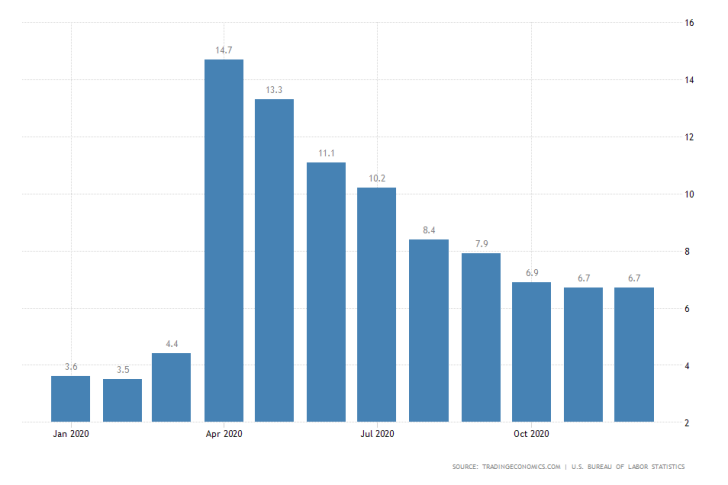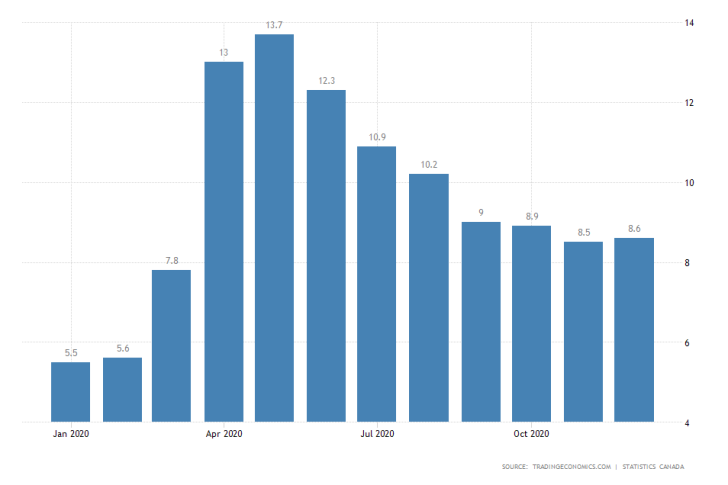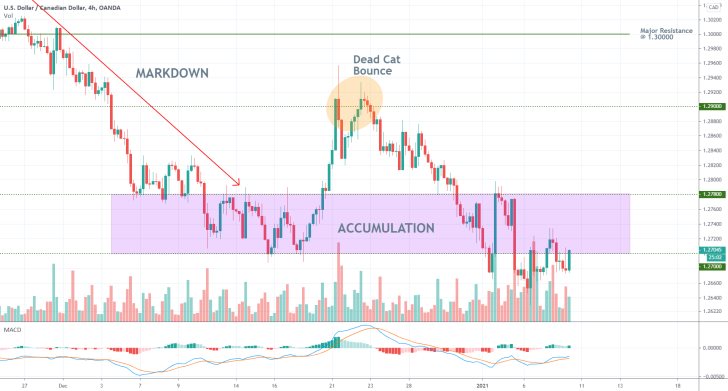
The U.S. Bureau of Labour Statistics (BLS) just released the December Non-Farm Payrolls. According to the labour market survey findings, the American economy has lost 140 thousand jobs over the last month of 2020.
The underlying performance was missed completely by the initial market forecasts, which were anticipating another expansion of the labour force by an additional 60 thousand jobs. It also underpins a drastic dive from the 245 thousand new jobs that were created in November.

Even still, headline unemployment was reported at 6.7 per cent for the second consecutive month. This is welcoming news given that an uptick by 0.1 per cent was expected to be observed. This also marks the first instance in seven months that the American economic recovery was not robust enough to reduce headline unemployment.
The immediate market reaction was somewhat subdued by the fact that the preliminary ADP report had already demonstrated the decline in jobs two days prior. That is why the adverse impact of the news was cushioned.
Meanwhile, the situation in the U.S.' northern neighbour is even gloomier. Statistics Canada revealed that the national labour force has contracted by 62.6 thousand jobs in December, which completely invalidates the 62.1 thousand new positions that were created in November.
Canadian unemployment thus climbs marginally by 0.1 per cent to 8.6 per cent over the same period.

The December payrolls thus failed to deliver the much-needed pain relief for the reeling U.S. dollar, which continues to be struggling against the Loonie. The greenback is greatly disadvantaged by the historically low yields, as global investors' demand for the currency wanes. Meanwhile, the Canadian dollar is supported by rising oil prices.
As shown on the 4H chart below, the pair's price action is currently concentrated below the lower boundary of a massive Accumulation range. It remains to be seen whether this will pan out to be a minor Spring formation, or the preceding Markdown will be continued instead.
The development of a Dead Cat Bounce pattern could be an affirmation of the second possibility. Moreover, the underlying momentum remains ostensibly bearish, as demonstrated by the MACD indicator.
Nevertheless, there is increasing evidence suggesting that the greenback could recuperate soon.

Trendsharks Premium
Gold is undergoing a correction, as investors take profits to offset losses from falling stock prices, impacting their margins. However, we anticipate a renewed wave of [...]
The Swiss stock market index is mirroring its global counterparts, such as Germany 40 and US100, experiencing a sharp decline following the announcement of new [...]
We’re analyzing the weekly chart to grasp the broader market trend. Over the past three years, the US30 index has surged by 17,000 points, often resembling a nearly straight [...]
Over the past week, the DAX has experienced a sharp decline, plunging by an astonishing 3,400 points. This downward movement is not isolated, as its international counterparts, such as the UK100 and US100, are also facing significant [...]
EURUSD recently formed a double top at 1.0930, signaling a potential trend reversal, and has since begun a correction. After a 600-pip rally since early March, a pullback at this stage is both expected and healthy. Given these conditions, we are placing a [...]
Since early March, EURJPY has surged nearly 1,000 pips, providing us with several excellent trading opportunities. However, as the rally matures, many early buyers are beginning to take profits, leading to a noticeable slowdown in the uptrend. On Friday, the pair formed a [...]
The AUDJPY currency pair continues to be dominated by bullish momentum, as multiple golden cross patterns reaffirm the strength of the ongoing uptrend. Despite this, we are witnessing a much-needed [...]
The EURAUD currency pair appears to be undergoing a trend reversal, signaling a potential shift in market direction. A notable technical development is the formation of a Death Cross on the chart, a widely recognized bearish indicator that typically suggests a [...]
After securing an impressive 200-pip profit last week, the EURJPY currency pair is now undergoing a southward correction, retracing some of its recent gains. Despite this temporary pullback, the Golden Cross remains intact, reinforcing our view that the overall trend continues to be [...]
The appearance of a Golden Cross in Silver strengthens our analysis that the metal is currently in a strong uptrend, indicating further bullish momentum in the market. This technical pattern, where the short-term moving average crosses above the [...]
This trade presents a considerable level of risk and can be classified as an opportunistic move based on recent price action. The GBPUSD currency pair has experienced a substantial bullish rally, surging by nearly 500 pips in a strong upward movement. However, after this extended period of appreciation, the pair is showing signs of a potential [...]
The anticipated Death Cross on the SMI20 appears to be failing as price finds strong support at the 23% Fibonacci retracement level. After testing this area, the index has shown bullish strength, printing several large green candles, signaling an increase in [...]
A Golden Cross has just appeared on the USDJPY chart, signaling a potential bullish move. This technical pattern occurs when the 20 period moving average crosses above the 60 period moving average, a widely recognized indication of increasing [...]
After 2 months of a down trend, we finally see some indications of price recovery for Oil. The golden cross, a historic buy signal, supports this [...]
For the past month, the German DAX40 has experienced a remarkable 10% surge, reflecting strong bullish momentum. Despite ongoing market volatility and frequent pullbacks, every dip continues to attract fresh buyers, reinforcing the [...]
Oil continues its downward trajectory, despite occasional pullbacks. The overall trend remains bearish, reinforced by multiple Death Cross patterns, a classic sell signal indicating further weakness. Adding to this bearish outlook, the critical [...]
Over the past few days, gold has experienced a sharp decline of more than $100. This downturn can be attributed in part to traders securing profits to manage their margins, which are under strain due to the significant drop in major indices. Currently, gold has fallen below the [...]
The NASDAQ 100 index is showing strong bullish momentum, as evidenced by the formation of a Golden Cross on the chart. This classic buy signal occurs when the short moving average crosses above the long term moving average, suggesting that upward momentum is [...]
The EURAUD currency pair has encountered a significant resistance level, failing to break above the critical 61% Fibonacci retracement level. This suggests that bullish momentum is weakening, reinforcing the case for a potential downward move. Given this technical setup, we favor entering a [...]
The UK100 is experiencing a remarkable rally! Over the past few weeks, the British stock market index has surged nearly 800 points. Each minor dip has attracted more buyers, fueling the bullish momentum. However, since last week, we’ve observed a slight [...]




















